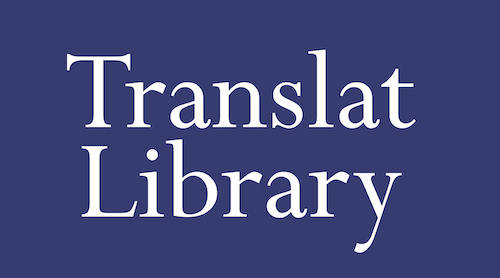Guidelines for Contributors
Style
Translat Library follows the 17th edition of the Chicago Manual of Style and a handful of in-house rules. When in conflict, our in-house rules take precedence over the manual. When formatting your essay please refer to the manual if you have any questions that exceed the scope of these guidelines. The Chicago Manual of Style is available online by subscription (https://www.chicagomanualofstyle.org/). Publication of an accepted essay is contingent upon submission of a final version compliant with our style sheet.
Format
Submissions should be formatted in Times New Roman, sizes 12 (for the main text) and 10 (for the footnotes), with one-inch margins. Double-space throughout.
Length
Essays should not exceed 4,000 words in length. There is no word limit for editions, but introductions to those should not exceed the 4,000-word limit.
Abstract and Keywords
Include a 100- to 150-word abstract and six keywords with your submission. If your essay is written in a language other than English, please include one abstract in English and one in the language of your work.
Works Cited
Compile a list of works cited at the end of the document and, when necessary, a list of manuscripts cited and of rare editions cited. Place the later before the list of works cited. If there are digital copies available of the manuscripts and rare editions cited, also include their DOIs or URLs.
Images
Paste supporting images directly on the main text of your submission. Include serially numbered captions below each image (Figure 1, Figure 2, etc.). Upon acceptance, you will need to provide clearly labeled files and reproduction permissions for each figure.
Title and Affiliation
Use roman type for the title. Center it. Include your name below in small caps and your affiliation, in cursive, underneath.
Paragraphs
Indent the first line of every paragraph (including footnotes) except in the first line of the essay, the first line after a section heading, and the first line of every block quotation.
Block Quotations
Set quotations of four lines and longer off the main text by leaving a blank line before and after the quotation. Indent the whole paragraph or paragraphs.
Italics
Use italics for work titles, words in languages other than the language of the essay, and metalinguistic references (e.g., “the letter e,” “this is how the author used rosech”).
Boldface
Do not use boldface in any case.
Double Quotes
Use double quotes (“ ”) for short in-text quotations and around the title of journal articles. If writing your contribution in a Romance language, use guillemets (« ») instead. Single quotes (‘ ’) will be used for concise translations.
Dashes
Use the em dash (—) for parenthetical asides and the en dash (–) for number ranges or spans.
Brackets
Use brackets ([ ]) to indicate editorial interventions in quotations or edited texts. Use three dots between brackets to indicate omissions ([…]).
Footnotes
Footnotes should be kept to a minimum. If any bibliographical discussions are necessary, integrate those in the main text. Footnote numbers should be placed at the end of the sentence, following punctuation signs.
Bibliographical References
Strictly limit the use of author-date references to support assertions, such as
- Martí de Riquer (1945: 44) defended this interpretation.
- This interpretation gained currency thanks to its first proponent (Riquer 1964, 1:264)
Works Cited
List the works cited in the text. Arrange them alphabetically by author’s name. Two works by the same author can be arranged chronologically (e.g., Riquer 1943, Riquer 1956). Distinguish two works by the same author that were published on the same year by appending a letter next to the date (e.g., Rubió i Balaguer 1961a, Rubió i Balaguer 1961b, etc.). Include their DOI when available.
- Badia, Lola. 2000. “Entre los amores deleitables petrarquescos y la condenada opinión de Epicuro: En el laberinto de Lo somni de Bernat Metge.” In Actas del VIII Congreso Internacional de la AHLM (Santander, 22–26 de septiembre de 1999), 2 vols., edited by Margarita Freixas, Silvia Iriso, and Laura Fernández, 1:257–68. Santander: Gobierno de Cantabria, AHLM.
- Di Girolamo, Costanzo.
- March, Ausiàs. 2004. Páginas del Cancionero, edited by Costanzo Di Girolamo, translated by José María Mico. Valencia: Pre-Textos.
- Grafton, Anthony. 1991. Defenders of the Text: The Traditions of Scholarship in an Age of Science, 1450–1480. Cambridge, MA: Harvard University Press.
- Kraye, Jill A. 2011. “Unpacking the Warburg Library.” Common Knowledge 18, no.1 (Winter): 117–27.
- Rico, Francisco. 1998. “Nobiltà del Medioevo, nobiltà dell’Umanesimo.” In Gli umanesimi medievali: Atti del II Congresso dell’Internationales Mittellateinerkomitee (Firenze, Certosa del Galluzzo, 11–15 settembre 1993), edited by Claudio Leonardi, 59–66. Florence: SISMEL, Edizioni del Galluzzo.
Manuscripts and Rare Books
To cite a manuscript or a rare book, spell out the reference the first time you ,mention it (e.g., Barcelona, Arxiu Històric de la Ciutat de Barcelona, 1G MS 35, fols. 2r–3v; Barcelona, Biblioteca de Catalunya, Bon. 10-VI-29, fols. 4r–5v), and use one consistent abbreviated form thereafter (e.g., MS 35, AHCM 35, Bon. 10-VI-29, etc.). List manuscripts and rare books in alphabetical order, by city, at the end of the essay.
